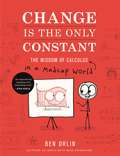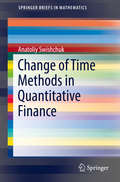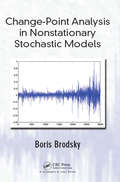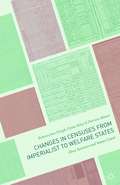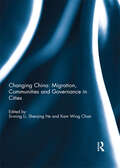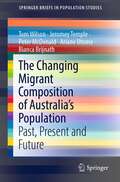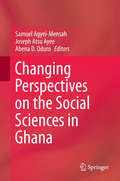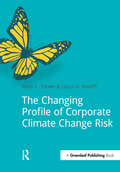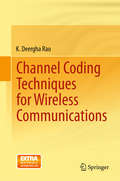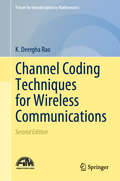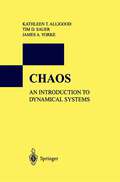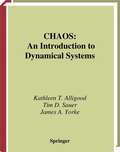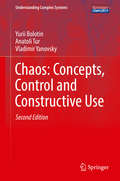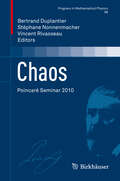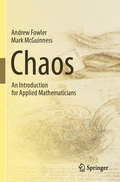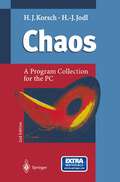- Table View
- List View
Change Is the Only Constant: The Wisdom of Calculus in a Madcap World
by Ben OrlinThe next book from Ben Orlin, the popular math blogger and author of the underground bestseller Math With Bad Drawings. Change Is The Only Constant is an engaging and eloquent exploration of the intersection between calculus and daily life, complete with Orlin's sly humor and wonderfully bad drawings. Change is the Only Constant is an engaging and eloquent exploration of the intersection between calculus and daily life, complete with Orlin's sly humor and memorably bad drawings. By spinning 28 engaging mathematical tales, Orlin shows us that calculus is simply another language to express the very things we humans grapple with every day -- love, risk, time, and most importantly, change. Divided into two parts, "Moments" and "Eternities," and drawing on everyone from Sherlock Holmes to Mark Twain to David Foster Wallace, Change is the Only Constant unearths connections between calculus, art, literature, and a beloved dog named Elvis. This is not just math for math's sake; it's math for the sake of becoming a wiser and more thoughtful human.
Change Is the Only Constant: The Wisdom of Calculus in a Madcap World
by Ben OrlinThe next book from Ben Orlin, the popular math blogger and author of the underground bestseller Math With Bad Drawings.Change Is The Only Constant is an engaging and eloquent exploration of the intersection between calculus and daily life, complete with Orlin's sly humor and wonderfully bad drawings. Change is the Only Constant is an engaging and eloquent exploration of the intersection between calculus and daily life, complete with Orlin's sly humor and memorably bad drawings. By spinning 28 engaging mathematical tales, Orlin shows us that calculus is simply another language to express the very things we humans grapple with every day -- love, risk, time, and most importantly, change. Divided into two parts, "Moments" and "Eternities," and drawing on everyone from Sherlock Holmes to Mark Twain to David Foster Wallace, Change is the Only Constant unearths connections between calculus, art, literature, and a beloved dog named Elvis. This is not just math for math's sake; it's math for the sake of becoming a wiser and more thoughtful human.
Change of Time Methods in Quantitative Finance (SpringerBriefs in Mathematics)
by Anatoliy SwishchukThis book is devoted to the history of Change of Time Methods (CTM), the connections of CTM to stochastic volatilities and finance, fundamental aspects of the theory of CTM, basic concepts, and its properties. An emphasis is given on many applications of CTM in financial and energy markets, and the presented numerical examples are based on real data. The change of time method is applied to derive the well-known Black-Scholes formula for European call options, and to derive an explicit option pricing formula for a European call option for a mean-reverting model for commodity prices. Explicit formulas are also derived for variance and volatility swaps for financial markets with a stochastic volatility following a classical and delayed Heston model. The CTM is applied to price financial and energy derivatives for one-factor and multi-factor alpha-stable Levy-based models. Readers should have a basic knowledge of probability and statistics, and some familiarity with stochastic processes, such as Brownian motion, Levy process and martingale.
Change-Point Analysis in Nonstationary Stochastic Models
by Boris BrodskyThis book covers the development of methods for detection and estimation of changes in complex systems. These systems are generally described by nonstationary stochastic models, which comprise both static and dynamic regimes, linear and nonlinear dynamics, and constant and time-variant structures of such systems. It covers both retrospective and sequential problems, particularly theoretical methods of optimal detection. Such methods are constructed and their characteristics are analyzed both theoretically and experimentally. Suitable for researchers working in change-point analysis and stochastic modelling, the book includes theoretical details combined with computer simulations and practical applications. Its rigorous approach will be appreciated by those looking to delve into the details of the methods, as well as those looking to apply them.
Change-Point Analysis in Nonstationary Stochastic Models
by Boris BrodskyThis book covers the development of methods for detection and estimation of changes in complex systems. These systems are generally described by nonstationary stochastic models, which comprise both static and dynamic regimes, linear and nonlinear dynamics, and constant and time-variant structures of such systems. It covers both retrospective and sequential problems, particularly theoretical methods of optimal detection. Such methods are constructed and their characteristics are analyzed both theoretically and experimentally. Suitable for researchers working in change-point analysis and stochastic modelling, the book includes theoretical details combined with computer simulations and practical applications. Its rigorous approach will be appreciated by those looking to delve into the details of the methods, as well as those looking to apply them.
Changes in Censuses from Imperialist to Welfare States: How Societies and States Count
by Dylan Riley Rebecca Jean Emigh Patricia AhmedChanges in Censuses from Imperialist to Welfare States , the second of two volumes, uses historical and comparative methods to analyze censuses or census-like information in the United Kingdom, the United States, and Italy, starting in England over one-thousand years ago.
Changes in Work and Family Life in Japan Under COVID-19 (SpringerBriefs in Population Studies)
by Shigeki Matsuda Hirohisa TakenoshitaThis book describes how the COVID-19 pandemic has affected the way of work, the division of household labor, and family formation in Japan. One of the characteristics of Japanese employment practices is a stable employer–employment relationship and seniority-based wage system. In return, long working hours, especially for men who are called “salarymen” (salaried workers, or “company men”), are required. The pandemic has led to an expansion of telework and has reduced their working hours, which has made them return to their homes to work. In contrast, non-regular employees, who are mostly women, has become more unstable in employment and their incomes fell. This tendency has become even stronger under the pandemic.Compared with conditions in Western countries, in Japan wives have a greater responsibility for domestic chores. In the pandemic, as children's classes shifted to online and childcare support facilities were temporarily closed, the burden of housework and child-rearing increased for wives. However, husbands who worked from home shared a part of the housework, and popular home delivery services helped to reduce the burdens on wives. Japan is one of the developed countries with low fertility rates. Under the pandemic, many Japanese postponed starting a family, which further shrank the country’s birthrate. There was a remarkably significant tendency to postpone having children among economically disadvantaged and socially isolated families. This book provides a portrait of Japan’s experience regarding the notable impacts of the pandemic on work and family life.
Changing Age and Career Concepts in the Austrian Banking Industry: A Case Study of Middle-Aged Non-managerial Employees and Managers (Contributions to Management Science)
by Barbara Marina Covarrubias VenegasDemographic change is affecting societies and organizations alike. Although ageing is relevant to all, there is still a tendency for more negative stereotypes to be attributed to older individuals, while positive stereotypes are mainly associated with younger individuals. Further, there are indications of gendered ageism, showing that age prejudices are more likely to affect women. This book argues that, through holistic measures, human resources management is of fundamental importance to an age-friendly and non-age-discriminatory culture. It can be assumed that awareness-raising on age issues also takes into account the gender issue. Drawing on qualitative interviews with employees in the Austrian banking industry and using an analytical framework, the author provides suggestions and implications for organizations to address this situation.
Changing China: Migration, Communities and Governance in Cities
by Li Li Si-Ming Shenjing Shenjing He Kam Wing ChanChina’s unprecedented urbanization is underpinned by not only massive rural-urban migration but also a household registration system embedded in a territorial hierarchy that produces lingering urban-rural duality. The mid-1990s onwards witnessed increasing reliance on land revenues by municipal governments, causing repeated redrawing of city boundaries to incorporate surrounding countryside. The identification of real estate as a growth anchor further fueled urban expansion. Sprawling commodity housing estates proliferate on urban-rural fringes, juxtaposed with historical villages undergoing intense densification. The traditional urban core and work-unit compounds also undergo wholesale redevelopment. Alongside large influx of migrants, major reshuffling of population has taken place inside metropolitan areas. Chinese cities today are more differentiated than ever, with new communities superimposing and superseding older ones. The rise of the urban middle class, in particular, has facilitated the formation of homeowners’ associations, and poses major challenges to hitherto state dominated local governance.The present volume tries to more deeply unravel and delineate the intertwining forms and processes outlined above from a variety of angles: circulatory, mobility and precariousness; urbanization, diversity and segregation; and community and local governance. Contributors include scholars of Chinese cities from mainland China, Hong Kong, Canada, Australia and the United States. This volume was previously published as a special issue of Eurasian Geography and Economics.
Changing China: Migration, Communities and Governance in Cities
by Si-ming Li, Shenjing He and Kam Wing ChanChina’s unprecedented urbanization is underpinned by not only massive rural-urban migration but also a household registration system embedded in a territorial hierarchy that produces lingering urban-rural duality. The mid-1990s onwards witnessed increasing reliance on land revenues by municipal governments, causing repeated redrawing of city boundaries to incorporate surrounding countryside. The identification of real estate as a growth anchor further fueled urban expansion. Sprawling commodity housing estates proliferate on urban-rural fringes, juxtaposed with historical villages undergoing intense densification. The traditional urban core and work-unit compounds also undergo wholesale redevelopment. Alongside large influx of migrants, major reshuffling of population has taken place inside metropolitan areas. Chinese cities today are more differentiated than ever, with new communities superimposing and superseding older ones. The rise of the urban middle class, in particular, has facilitated the formation of homeowners’ associations, and poses major challenges to hitherto state dominated local governance.The present volume tries to more deeply unravel and delineate the intertwining forms and processes outlined above from a variety of angles: circulatory, mobility and precariousness; urbanization, diversity and segregation; and community and local governance. Contributors include scholars of Chinese cities from mainland China, Hong Kong, Canada, Australia and the United States. This volume was previously published as a special issue of Eurasian Geography and Economics.
The Changing Migrant Composition of Australia’s Population: Past, Present and Future (SpringerBriefs in Population Studies)
by Tom Wilson Jeromey Temple Peter McDonald Ariane Utomo Bianca BrijnathThis book looks at how Australia's migrant population composition is likely to change over coming decades. The book divides Australia's population into 48 countries of birth groupings and projects the birthplace populations out to 2066 according to the range of scenarios. These projections indicate a massive shift in Australia’s migrant composition from a European to an Asian-dominated population over the coming decades—a change which can be interpreted as a third demographic transition. By providing detailed consideration of the implications of the changing population composition, this book is a great resource for academics, government and private sector services.
Changing Perspectives on the Social Sciences in Ghana
by Samuel Agyei-Mensah Joseph Atsu Ayee Abena D. OduroThis book is the first compilation of its kind that brings together discussions of the evolution of scholarship in different branches of the Social Sciences. It presents a comprehensive multi-disciplinary text exploring the changing dynamics of the Social Sciences in Ghana, offering a broader perspective from which to view the evolution, theory, methods, substance and relevance of each of the Social Science disciplines and their multiple interfaces. The introduction and the conclusion are devoted to the theoretical, comparative and empirical debate over the Social Sciences from historical and analytical perspectives. Written by acknowledged experts, the 15 chapters span the following disciplines: Archaeology and Heritage Studies; History; Geography; Psychology; Sociology and Anthropology; Social Work; Economics; Political Science; International Affairs; Information Studies; Communication Studies; African Studies; Development Studies; Women’s and Gender Studies and Adult and Continuing Education.Changing Perspectives on the Social Sciences in Ghana offers sophisticated perspectives for comparing and appreciating the synergies, differences, trends and nuances among and between the Social Science disciplines in Ghana, in a holistic and scholarly manner.
The Changing Profile of Corporate Climate Change Risk
by Mark Trexler Laura KosloffThis book will help business executives to (1) rethink their perceptions of climate risk (2) evaluate whether their company is effectively positioned, and (3) make informed and prudent business decisions about climate change risk in an environment rife with policy uncertainty.Business risk associated with climate change is commonly assumed to be primarily policy driven. Many companies internalize the current stalemate over global climate policy into a perception that climate risk is no longer a critical issue. Business climate risks, however, include: Operational and Supply Chain (Physical) Risk, Brand Risk, Market-driven Structural Risk, Liability Risk.As national and global policy to materially reduce climate change is delayed, it is business-prudent to assume that the level of climate risk is increasing. Even if policy risk might seem lower today than a few years ago, political will can change quickly. Should physical impacts of climate change manifest in dramatic ways, for example, draconian climate policy is likely to follow quickly. These conditions create a complex and shifting business risk environment, and most companies either overlook or substantially underestimate key climate risks. How many companies, for example, are positioned for material climate change outcomes, whether physical or regulatory? Companies with little climate change exposure may not face much downside risk from taking a wait-and-see approach. For those with greater exposure, being "too late" to respond will mean costs and competitive impacts that could have been avoided. Being "too early," however, can mean being penalized later for actions that reduce a company’s emissions today, or competitive disadvantage from getting too far out in front of competitors.
The Changing Profile of Corporate Climate Change Risk
by Mark Trexler Laura KosloffThis book will help business executives to (1) rethink their perceptions of climate risk (2) evaluate whether their company is effectively positioned, and (3) make informed and prudent business decisions about climate change risk in an environment rife with policy uncertainty.Business risk associated with climate change is commonly assumed to be primarily policy driven. Many companies internalize the current stalemate over global climate policy into a perception that climate risk is no longer a critical issue. Business climate risks, however, include: Operational and Supply Chain (Physical) Risk, Brand Risk, Market-driven Structural Risk, Liability Risk.As national and global policy to materially reduce climate change is delayed, it is business-prudent to assume that the level of climate risk is increasing. Even if policy risk might seem lower today than a few years ago, political will can change quickly. Should physical impacts of climate change manifest in dramatic ways, for example, draconian climate policy is likely to follow quickly. These conditions create a complex and shifting business risk environment, and most companies either overlook or substantially underestimate key climate risks. How many companies, for example, are positioned for material climate change outcomes, whether physical or regulatory? Companies with little climate change exposure may not face much downside risk from taking a wait-and-see approach. For those with greater exposure, being "too late" to respond will mean costs and competitive impacts that could have been avoided. Being "too early," however, can mean being penalized later for actions that reduce a company’s emissions today, or competitive disadvantage from getting too far out in front of competitors.
Changing speed graphs (large print)
by RnibThis page shows two graphs plotting time against distance travelled for a moving object. There is a locator dot shown, which will be at the top left of the page when the image is the correct way up. There is one graph on the top of the page and one on the bottom. Both of the graphs have an X-axis on the bottom of the image and a Y-axis to the left side of the image. On each graph the X-axis runs horizontally across the page. It is marked and labelled for every 5 seconds from zero at the origin in the bottom left of the image to 20 seconds at the right. On each graph the Y-axis goes up the left of the page. It is marked and labelled for every 40 metres, starting at zero in the origin in the bottom left corner of the image going to 200 metres at the top. On each graph the heavy, dashed data line (red on the large print) goes from the origin in the bottom left of the graph to the top right.
Changing speed graphs (UEB contracted)
by RnibThis page shows two graphs plotting time against distance travelled for a moving object. There is a locator dot shown, which will be at the top left of the page when the image is the correct way up. There is one graph on the top of the page and one on the bottom. Both of the graphs have an X-axis on the bottom of the image and a Y-axis to the left side of the image. On each graph the X-axis runs horizontally across the page. It is marked and labelled for every 5 seconds from zero at the origin in the bottom left of the image to 20 seconds at the right. On each graph the Y-axis goes up the left of the page. It is marked and labelled for every 40 metres, starting at zero in the origin in the bottom left corner of the image going to 200 metres at the top. On each graph the heavy, dashed data line (red on the large print) goes from the origin in the bottom left of the graph to the top right.
Changing speed graphs (UEB uncontracted)
by RnibThis page shows two graphs plotting time against distance travelled for a moving object. There is a locator dot shown, which will be at the top left of the page when the image is the correct way up. There is one graph on the top of the page and one on the bottom. Both of the graphs have an X-axis on the bottom of the image and a Y-axis to the left side of the image. On each graph the X-axis runs horizontally across the page. It is marked and labelled for every 5 seconds from zero at the origin in the bottom left of the image to 20 seconds at the right. On each graph the Y-axis goes up the left of the page. It is marked and labelled for every 40 metres, starting at zero in the origin in the bottom left corner of the image going to 200 metres at the top. On each graph the heavy, dashed data line (red on the large print) goes from the origin in the bottom left of the graph to the top right.
Channel Coding Techniques for Wireless Communications
by K. Deergha RaoThe book discusses modern channel coding techniques for wireless communications such as turbo codes, low parity check codes (LDPC), space-time coding, Reed Solomon (RS) codes and convolutional codes. Many illustrative examples are included in each chapter for easy understanding of the coding techniques. The text is integrated with MATLAB-based programs to enhance the understanding of the subject’s underlying theories. It includes current topics of increasing importance such as turbo codes, LDPC codes, LT codes, Raptor codes and space-time coding in detail, in addition to the traditional codes such as cyclic codes, BCH and RS codes and convolutional codes. MIMO communications is a multiple antenna technology, which is an effective method for high-speed or high-reliability wireless communications. PC-based MATLAB m-files for the illustrative examples are included and also provided on the accompanying CD, which will help students and researchers involved in advanced and current concepts in coding theory. Channel coding, the core of digital communication and data storage, has undergone a major revolution as a result of the rapid growth of mobile and wireless communications.The book is divided into 11 chapters. Assuming no prior knowledge in the field of channel coding, the opening chapters (1 - 2) begin with basic theory and discuss how to improve the performance of wireless communication channels using channel coding. Chapters 3 and 4 introduce Galois fields and present detailed coverage of BCH codes and Reed-Solomon codes. Chapters 5–7 introduce the family of convolutional codes, hard and soft-decision Viterbi algorithms, turbo codes, BCJR algorithm for turbo decoding and studies trellis coded modulation (TCM), turbo trellis coded modulation (TTCM), bit-interleaved coded modulation (BICM) as well as iterative BICM (BICM-ID) and compares them under various channel conditions. Chapters 8 and 9 focus on low-density parity-check (LDPC) codes, LT codes and Raptor codes. Chapters 10 and 11 discuss MIMO systems and space-time (ST) coding.
Channel Coding Techniques for Wireless Communications (Forum for Interdisciplinary Mathematics)
by K. Deergha RaoThis book discusses the latest channel coding techniques, MIMO systems, and 5G channel coding evolution. It provides a comprehensive overview of channel coding, covering modern techniques such as turbo codes, low-density parity-check (LDPC) codes, space–time coding, polar codes, LT codes, and Raptor codes as well as the traditional codes such as cyclic codes, BCH, RS codes, and convolutional codes. It also explores MIMO communications, which is an effective method for high-speed or high-reliability wireless communications. It also examines the evolution of 5G channel coding techniques. Each of the 13 chapters features numerous illustrative examples for easy understanding of the coding techniques, and MATLAB-based programs are integrated in the text to enhance readers’ grasp of the underlying theories. Further, PC-based MATLAB m-files for illustrative examples are included for students and researchers involved in advanced and current concepts of coding theory.
Chaos: An Introduction to Dynamical Systems (Textbooks in Mathematical Sciences)
by Kathleen Alligood Tim Sauer J.A. YorkeBACKGROUND Sir Isaac Newton hrought to the world the idea of modeling the motion of physical systems with equations. It was necessary to invent calculus along the way, since fundamental equations of motion involve velocities and accelerations, of position. His greatest single success was his discovery that which are derivatives the motion of the planets and moons of the solar system resulted from a single fundamental source: the gravitational attraction of the hodies. He demonstrated that the ohserved motion of the planets could he explained hy assuming that there is a gravitational attraction he tween any two ohjects, a force that is proportional to the product of masses and inversely proportional to the square of the distance between them. The circular, elliptical, and parabolic orhits of astronomy were v INTRODUCTION no longer fundamental determinants of motion, but were approximations of laws specified with differential equations. His methods are now used in modeling motion and change in all areas of science. Subsequent generations of scientists extended the method of using differ ential equations to describe how physical systems evolve. But the method had a limitation. While the differential equations were sufficient to determine the behavior-in the sense that solutions of the equations did exist-it was frequently difficult to figure out what that behavior would be. It was often impossible to write down solutions in relatively simple algebraic expressions using a finite number of terms. Series solutions involving infinite sums often would not converge beyond some finite time.
Chaos: An Introduction to Dynamical Systems (Textbooks in Mathematical Sciences)
by Kathleen T. Alligood Tim D. Sauer James A. YorkeDeveloped and class-tested by a distinguished team of authors at two universities, this text is intended for courses in nonlinear dynamics in either mathematics or physics. The only prerequisites are calculus, differential equations, and linear algebra. Along with discussions of the major topics, including discrete dynamical systems, chaos, fractals, nonlinear differential equations and bifurcations, the text also includes Lab Visits -- short reports that illustrate relevant concepts from the physical, chemical and biological sciences. There are Computer Experiments throughout the text that present opportunities to explore dynamics through computer simulations, designed for use with any software package. And each chapter ends with a Challenge, guiding students through an advanced topic in the form of an extended exercise.
Chaos: Concepts, Control And Constructive Use (Understanding Complex Systems)
by Yurii Bolotin Anatoli Tur Vladimir YanovskyThis book offers a short and concise introduction to the many facets of chaos theory.While the study of chaotic behavior in nonlinear, dynamical systems is a well-established research field with ramifications in all areas of science, there is a lot to be learnt about how chaos can be controlled and, under appropriate conditions, can actually be constructive in the sense of becoming a control parameter for the system under investigation, stochastic resonance being a prime example.The present work stresses the latter aspects and, after recalling the paradigm changes introduced by the concept of chaos, leads the reader skillfully through the basics of chaos control by detailing the relevant algorithms for both Hamiltonian and dissipative systems, among others.The main part of the book is then devoted to the issue of synchronization in chaotic systems, an introduction to stochastic resonance, and a survey of ratchet models. In this second, revised and enlarged edition, two more chapters explore the many interfaces of quantum physics and dynamical systems, examining in turn statistical properties of energy spectra, quantum ratchets, and dynamical tunneling, among others.This text is particularly suitable for non-specialist scientists, engineers, and applied mathematical scientists from related areas, wishing to enter the field quickly and efficiently.From the reviews of the first edition: This book is an excellent introduction to the key concepts and control of chaos in (random) dynamical systems [...] The authors find an outstanding balance between main physical ideas and mathematical terminology to reach their audience in an impressive and lucid manner. This book is ideal for anybody who would like to grasp quickly the main issues related to chaos in discrete and continuous time. Henri Schurz, Zentralblatt MATH, Vol. 1178, 2010.
Chaos: Poincaré Seminar 2010 (Progress in Mathematical Physics #66)
by Bertrand Duplantier Stéphane Nonnenmacher Vincent RivasseauThis twelfth volume in the Poincaré Seminar Series presents a complete and interdisciplinary perspective on the concept of Chaos, both in classical mechanics in its deterministic version, and in quantum mechanics. This book expounds some of the most wide ranging questions in science, from uncovering the fingerprints of classical chaotic dynamics in quantum systems, to predicting the fate of our own planetary system. Its seven articles are also highly pedagogical, as befits their origin in lectures to a broad scientific audience. Highlights include a complete description by the mathematician É. Ghys of the paradigmatic Lorenz attractor, and of the famed Lorenz butterfly effect as it is understood today, illuminating the fundamental mathematical issues at play with deterministic chaos; a detailed account by the experimentalist S. Fauve of the masterpiece experiment, the von Kármán Sodium or VKS experiment, which established in 2007 the spontaneous generation of a magnetic field in a strongly turbulent flow, including its reversal, a model of Earth’s magnetic field; a simple toy model by the theorist U. Smilansky – the discrete Laplacian on finite d-regular expander graphs – which allows one to grasp the essential ingredients of quantum chaos, including its fundamental link to random matrix theory; a review by the mathematical physicists P. Bourgade and J.P. Keating, which illuminates the fascinating connection between the distribution of zeros of the Riemann ζ-function and the statistics of eigenvalues of random unitary matrices, which could ultimately provide a spectral interpretation for the zeros of the ζ-function, thus a proof of the celebrated Riemann Hypothesis itself; an article by a pioneer of experimental quantum chaos, H-J. Stöckmann, who shows in detail how experiments on the propagation of microwaves in 2D or 3D chaotic cavities beautifully verify theoretical predictions; a thorough presentation by the mathematical physicist S. Nonnenmacher of the “anatomy” of the eigenmodes of quantized chaotic systems, namely of their macroscopic localization properties, as ruled by the Quantum Ergodic theorem, and of the deep mathematical challenge posed by their fluctuations at the microscopic scale; a review, both historical and scientific, by the astronomer J. Laskar on the stability, hence the fate, of the chaotic Solar planetary system we live in, a subject where he made groundbreaking contributions, including the probabilistic estimate of possible planetary collisions. This book should be of broad general interest to both physicists and mathematicians.
Chaos: An Introduction for Applied Mathematicians
by Andrew Fowler Mark McGuinnessThis is a textbook on chaos and nonlinear dynamics, written by applied mathematicians for applied mathematicians. It aims to tread a middle ground between the mathematician's rigour and the physicist’s pragmatism.While the subject matter is now classical and can be found in many other books, what distinguishes this book is its philosophical approach, its breadth, its conciseness, and its exploration of intellectual byways, as well as its liberal and informative use of illustration. Written at the graduate student level, the book occasionally drifts from classical material to explore new avenues of thought, sometimes in the exercises. A key feature of the book is its holistic approach, encompassing the development of the subject since the time of Poincaré, and including detailed material on maps, homoclinic bifurcations, Hamiltonian systems, as well as more eclectic items such as Julia and Mandelbrot sets. Some of the more involved codes to produce the figures are described in the appendix.Based on lectures to upper undergraduates and beginning graduate students, this textbook is ideally suited for courses at this level and each chapter includes a set of exercises of varying levels of difficulty.
Chaos: A Program Collection for the PC
by Hans Jürgen Korsch Hans-Jörg JodlChaos: A Program Collection for the PC presents an outstanding selection of executable programs with introductory texts to chaos theory and its simulation. Students in physics, mathematics, and engineering will find a thorough introduction to fundamentals and applications in this field. Many numerical experiments and suggestions for further studies help the reader to become familiar with this fascinating topic. The second edition includes one CD-ROM, the executable programs are Windows 95 compatible.
